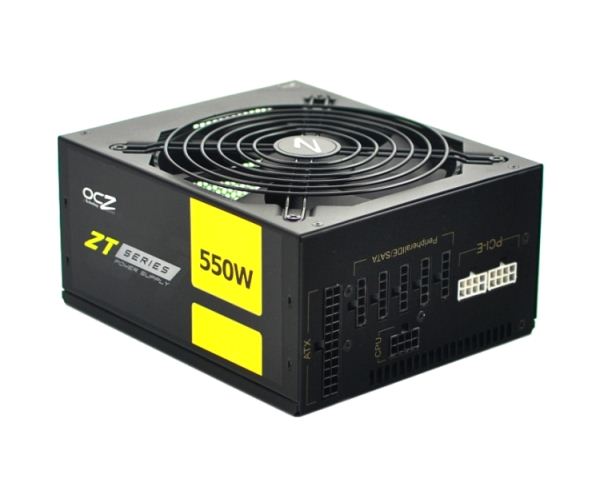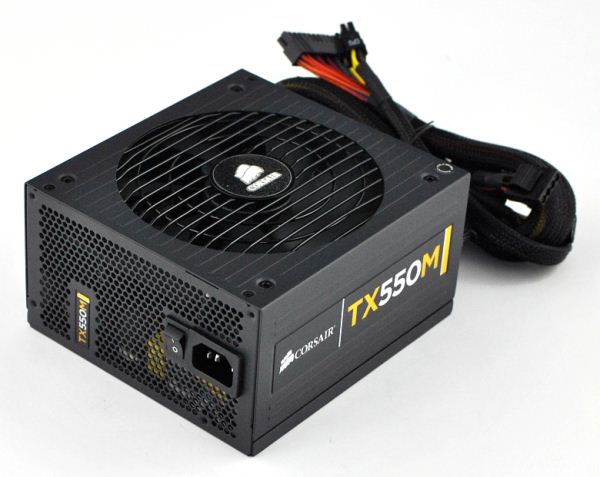Corsair TX vs. OCZ ZT 550W
by Martin Kaffei on March 26, 2012 9:30 AM EST- Posted in
- Cases/Cooling/PSUs
- Corsair
- PSUs
- OCZ
- 550W
- 80Plus Bronze
- ZT
- TX
Corsair TX550M vs. OCZ ZT550W 550W
In this review we will compare two almost identical products from OCZ and Corsair. Even so, there are still crucial differences between the offerings. With 550W both PSUs deliver more than enough power for most current systems. On the following pages we'll find out which handle overload situations the best, who has the highest efficiency, and which PSU provides the best voltage regulation.
The ZT models from OCZ are based on a Great Wall design with some modifications in the details. Interesting features include the fully modular cable management and a silent fan control. Today we will review the smallest version with 550W. Here's a complete rundown of the features.
- Available in 550W, 650W, 750W
- Single +12V rail
- Fully Modular Cabling System
- Dimensions: 150 x 86 x 175mm (W x L x H)
- 80-Plus Bronze Certified
- MTBF: 100,000 hours
- 5-year warranty
- 140mm ball-bearing fan
- Active PFC
- ATX 12V 2.2 Compliant
The second unit we test today is a Corsair TX produced by CWT. "Enthusiast Series is designed for reliable operation in high-performance PCs where clean, stable power is important." It's able to deliver the full output power at an ambient temperature of up to 50° Celsius. Like OCZ Corsair uses a double ball-bearing fan. Except the cables with mainboard connectors all cables are modular. In addition the fan grille looks unusual.
- Available in 550W, 650W, 750W, 850W
- Single +12V rail
- Modular Cabling System
- Dimensions:150 x 86 x 160mm (W x L x H)
- 80-Plus Bronze Certified
- MTBF: 100,000 hours
- 5-year warranty
- 140mm ball-bearing fan
- Active PFC
- ATX 12V 2.31 Compliant












41 Comments
View All Comments
Stuka87 - Monday, March 26, 2012 - link
On the last page where things are being highlighted, shouldn't the Corsair be highlighted for efficiency and ripple since it was ahead in these categories? Unless the yellow is just meant to show there is a difference. But it seams in the rest of the areas the better supply is highlighted.Both supplies look pretty good though, even if priced a bit higher than some similar supplies.
Martin Kaffei - Monday, March 26, 2012 - link
Sounds more correct, right.Thanks a lot.
lyeoh - Monday, March 26, 2012 - link
Has Corsair really improved their quality since: http://www.behardware.com/articles/843-3/component...FWIW, OCZ and Corsair's nonPSU stuff seem to get returned quite often too:
http://www.behardware.com/articles/843-4/component...
http://www.behardware.com/articles/843-7/component...
http://www.behardware.com/articles/843-8/component...
Both these PSUs might be OK, but why should I care? There are other manufacturers who have a better track record when it comes to quality. Poor quality in a range of similar models is understandable, but poor quality in different types/classes of products just tells me to avoid buying anything from them.
I'd prefer to see more reviews of products from manufacturers that care about quality. Who the heck wants to read reviews of food from restaurants that have a long track record of giving a significant percentage of their customers food poisoning? I don't care how good their food looks.
Are these even significantly cheaper?
Samus - Tuesday, March 27, 2012 - link
My advice to you is stop reading BEHardware.Those statistics for every segment they 'measured' are a joke. Just drafting such a distasteful article is a huge lapse in journalism judgement on their part. Nobody in their right mind would gauge component reliability based on return rates over a 6-month period from a single source.
The only way to measure reliability is by reviewing the initial quality in detail and putting the components into real-world scenarios to report any abnormalities over time. AnandTech and other legitimate hardware review sites do this, as does Car & Driver, Consumer Reports, Home Theater Review, Gun Directory, etc
seanleeforever - Tuesday, March 27, 2012 - link
while i agree with your point of view, but AnandTech rarely review abnormalities over time. and bear in mind AnandTech is more akin to C&D not CR because AnandTech receives cherry picked product directly from manufactures. and you really have to hope what you buy from your local frys is the same as the one they choose to send for reviewing.lyeoh - Thursday, March 29, 2012 - link
6 month period? OCZ's poor track record goes way back longer than that: http://www.behardware.com/articles/831-7/component...http://www.behardware.com/articles/831-4/component...
http://www.behardware.com/articles/810-6/component...
http://www.behardware.com/articles/810-4/component...
You haven't even provided a good reason why anyone should care about your opinion on this subject especially since you said "6 month period".
I'd believe BeHardware's article more than I'd believe you, especially since a few simple Google searches for product problems do not disagree with their statistics. So it's not just a freak incident where only the french retailer has higher rate of returns for OCZ and corsair stuff.
fausto412 - Monday, March 26, 2012 - link
I have a 6990 and a n AX850 PSU...that psu gets super hot when gaming. Can't imagine a 550 watt psu not melting. I think the days of the 550 watt psu are over unless you only do single card gaming and don't use the highest end cards.Ken g6 - Monday, March 26, 2012 - link
Did you miss the GTX 680 review the other day? http://www.anandtech.com/show/5699/nvidia-geforce-... The 7970 would work fine with a 550W PSU too.Also recall that the 6990 is effectively two cards in crossfire on a single board.
Samus - Tuesday, March 27, 2012 - link
I run a GTX570, Core i7-950, 12GB RAM, 5 hard drives and some other shit off a PCP&C 500-watt PSU. Whole system is reasonably warm after hours of gaming and is completely stable.Kill-A-Watt has never reported more than 400-watts drawn from the wall, so my 500-watt PSU never even hits 80% load.
Any never system with a single GPU draws less power, I guarantee it. 550-watt is overkill for most people with current technology. Remember most OEM systems still ship with 250-watt PSU's.
Stuka87 - Monday, March 26, 2012 - link
I use a Antec NEO-ECO 520C with my over clocked 7950 and its perfectly fine. I never get anywhere close to even 400W at peak (And thats with a 4.1GHz Phenom II) when measured at the wall. The latest chips from AMD and nVidia are incredibly efficient. The 6990 is a pretty big power hog comparatively, and it is a dual GPU card.